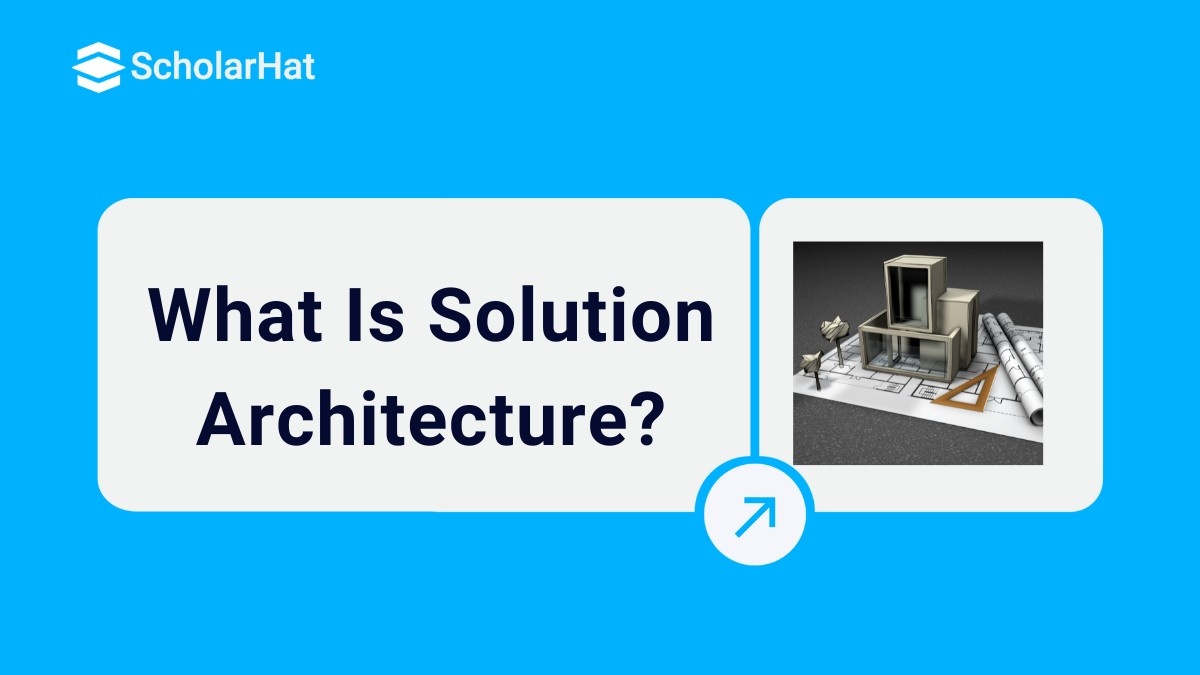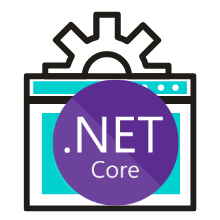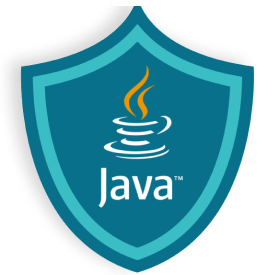26
DecWhat Is Solution Architecture? Key Concepts, Roles, and Benefits
Solution architecture is the process of planning and designing a customized technology solution to solve a specific business problem or fulfill a particular need. It involves developing a clear blueprint that brings together different elements such as software, hardware, networks, and workflows into a unified system. The goal of solution architecture is to create a realistic, actionable plan that supports business objectives while staying within defined constraints.
What is Solution Architecture?
Solution architecture is the process of planning to build a complete system that solves a specific business problem. It involves figuring out how different parts like software, hardware, networks, and processes will work together as one system.
Examples
- For example, consider a hospital that wants to improve patient care; it can use solution architecture to connect different systems like electronic health records, appointment scheduling, lab results, and billing. This will help doctors and staff access all the information they need in one place.
- Take another example of a school that wants to switch to online learning. Solution architecture can help design a system that combines video classes, student portals, grading tools, and communication platforms into one easy-to-use setup.

| Master Solution Architecture: Join Our .NET & Java Training Programs | |
| Java Solution Architect Certification Training | Book a Free Demo |
| .NET Solution Architect Certification Training | Book a Free Demo |
Who is a Solution Architect?
Solution architects possess deep knowledge of relevant technologies, systems, and processes such as software development, cloud services, business analysis, and project management. They collaborate closely with diverse teams, including business leaders, IT personnel, project managers, and end users. Their role involves understanding each group's goals and challenges to craft solutions that effectively address everyone's needs.
Roles and Responsibilities of Solution Architect
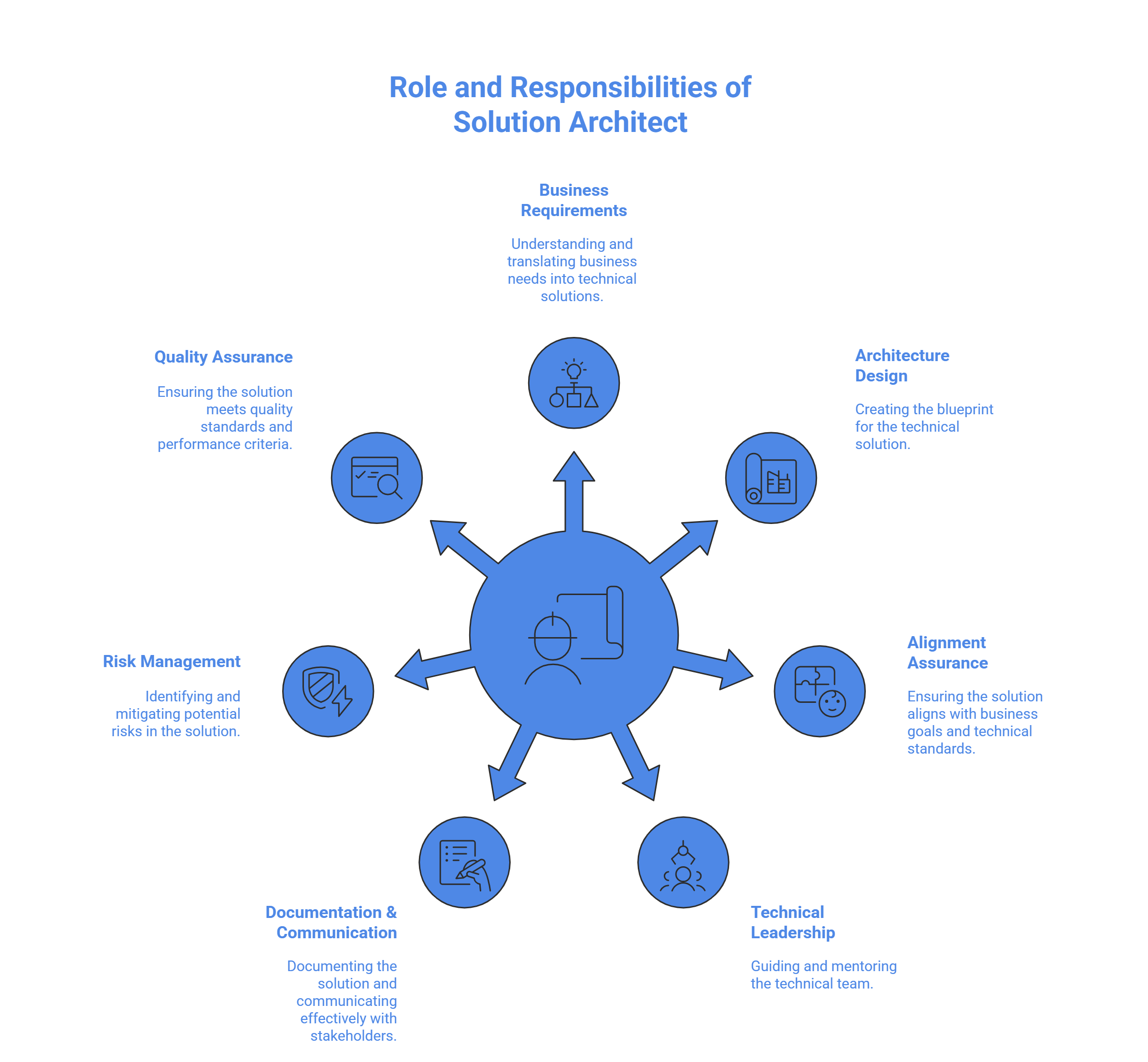
The following are the roles and Responsibilities of a Solution Architect in IT Projects:
1. Understanding Business Requirements
- They have to work with stakeholders (e.g., business analysts, product owners, executives) to understand business goals and constraints.
- They understand the business needs and then convert them into technical solutions.
2. Designing the Architecture
- They design the overall structure of a solution, including application components, data flow, integration points, and security.
- Choose appropriate technologies (e.g., cloud services, databases, APIs, frameworks) based on the use case.
3. Ensuring Alignment
- Align the solution with enterprise architecture, IT standards, and long-term strategy.
- Collaborate with domain architects (e.g., security, data, infrastructure) and development teams.
4. Technical Leadership
- Guide development teams during implementation.
- Make critical decisions on trade-offs, scalability, performance, and security.
5. Documentation & Communication
- Create architectural diagrams, specifications, and technical documentation.
- Communicate architecture decisions to technical and non-technical stakeholders.
6. Risk Management
- Identify technical risks and propose mitigation strategies.
- Ensure compliance with regulatory and security standards.
7. Quality Assurance
- Participate in code and architecture reviews.
- Ensure the solution meets quality and performance benchmarks.
| Read More: Roles and Responsibilities of a Solution Architect |
Solution Architecture Process
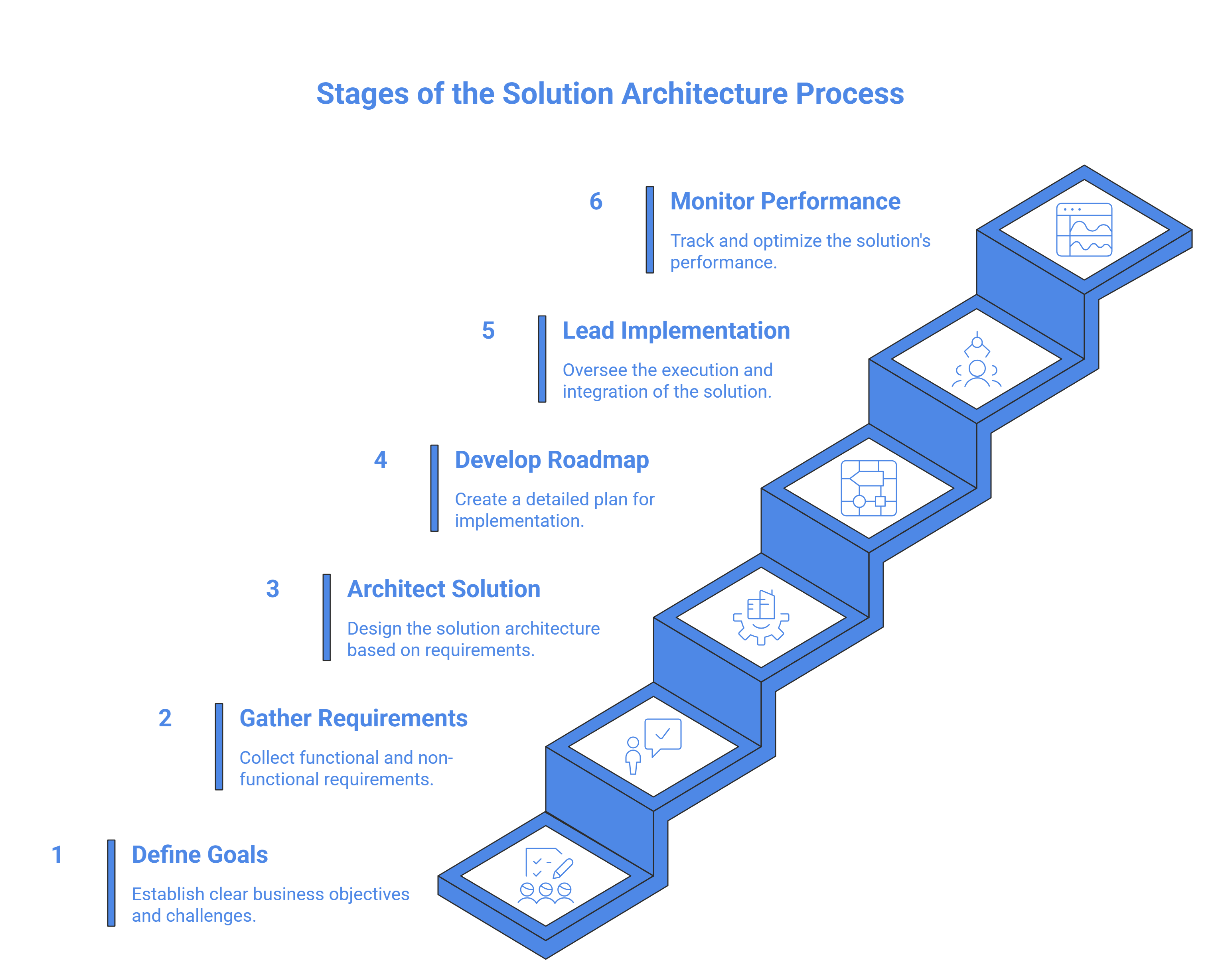
The following are stages of the Solution Architecture Process:
1. Define Business Goals and Challenges
Understand the problems the organization is facing and what it aims to achieve through the proposed solution. Identify risks or barriers that could hinder success.
2. Gather Functional and Non-Functional Requirements
Collect input from all stakeholders to determine what the solution must do (functional) and how it must perform (non-functional), covering aspects like security, usability, reliability, and compliance.
3. Architect the Solution
Develop high-level conceptual designs that show how system components interact. Select a suitable technology stack, estimate costs, and ensure alignment with business and technical needs.
4. Develop an Implementation Roadmap
Outline a step-by-step plan detailing how the solution will be rolled out, including timelines, resource allocation, responsibilities, and integration with existing systems.
5. Lead Implementation and Integration
Oversee the deployment of the solution, ensuring all components are delivered as planned and that the system integrates seamlessly with the organization’s infrastructure and architecture.
6. Monitor Performance and Optimize
After implementation, continuously track system performance, usage, and business impact. Identify opportunities for improvement and adjust the solution as needed to ensure continued success.
Main Components of a Solution Architecture Design
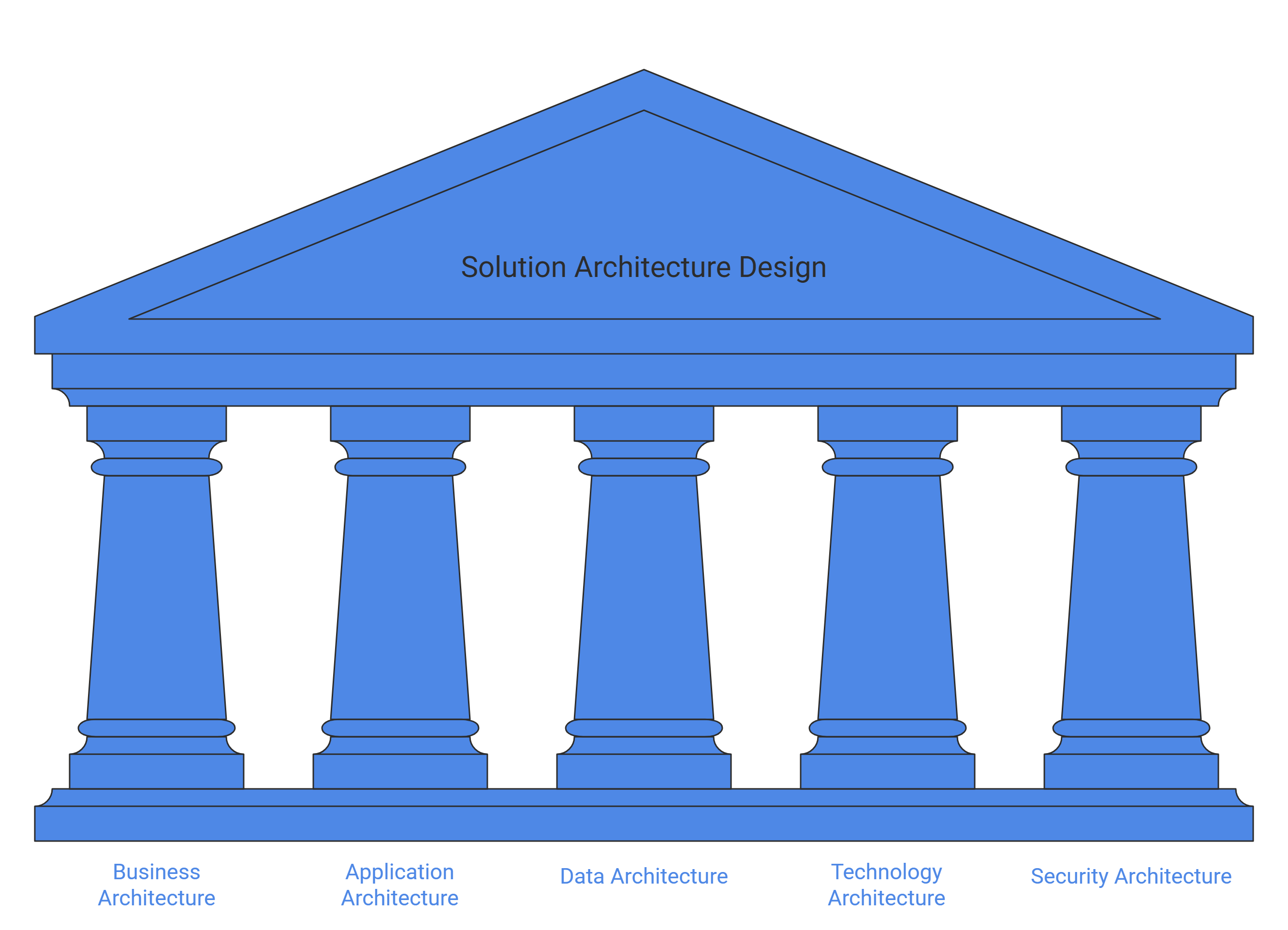
Below is a breakdown of the five key components that make up a typical solution architecture design:
1. Business Architecture
At the foundation of any solution lies the business architecture. This layer defines the business context of the solution—its purpose, goals, and the processes it supports. It focuses on understanding what the organization aims to achieve and ensures that the technology solution directly contributes to those strategic objectives.
Business architecture captures:
- Organizational goals and key performance indicators (KPIs)
- Core business processes and workflows
- Stakeholder roles, needs, and expectations
By clearly mapping out these elements, solution architects ensure that the technology being built serves real business value rather than just technical performance.
2. Application Architecture
The application architecture layer defines the structure and behavior of the software applications within the solution. This includes how different software modules interact, what services are provided, and how they connect and with external systems.
Key aspects of this layer include:
- Application components and their responsibilities
- Service interfaces and APIs
- User experience design and application workflows
A well-defined application architecture promotes modularity, maintainability, and scalability, ensuring that applications can grow and evolve along with business needs.
3. Data Architecture
Data is often the most valuable asset of any organization. The data architecture layer focuses on how data is collected, stored, processed, and shared across the solution. It also addresses data quality, consistency, and security.
This layer includes:
- Data models and entity relationships
- Data flow diagrams and integration logic
- Storage systems such as databases and data lakes
Effective data architecture ensures that the right people have access to the right data at the right time, supporting informed decision-making and operational efficiency.
4. Technology Architecture
Technology architecture deals with the underlying infrastructure and tools that support the solution. This includes the selection of platforms, hardware, networks, cloud services, and development tools.
Critical components in this layer are:
- Infrastructure (on-premises, cloud, or hybrid)
- Development environments and frameworks
- Deployment pipelines and DevOps strategies
- By defining a solid technology architecture, the solution can achieve high levels of availability, performance, and resilience, even under demanding conditions.
5. Security Architecture
Security is a cross-cutting concern that must be embedded in every layer of the solution. The security architecture outlines the policies, controls, and mechanisms required to protect the solution from threats and ensure compliance with regulations.
Key security considerations include:
- Identity and access management (IAM)
- Data encryption and privacy protocols
- Security monitoring and incident response planning
With growing risks from cyberattacks and data breaches, a strong security architecture is not optional—it’s essential.
Top Business Benefits of Implementing Solution Architecture
1. Maximizing Technology Value and Relevance
Solution Architects stay up to date with emerging technologies and industry trends. They assess which tools, platforms, or frameworks best match the organization’s goals, ensuring that each project adopts technologies that are not only current but also deliver long-term value and improve team productivity.
2. Translating Business Goals into Technical Solutions
A Solution Architect bridges the gap between business stakeholders and technical teams. By understanding the needs of the business, they craft realistic and actionable technical solutions that directly support strategic objectives. This ensures that every aspect of the solution serves a clear business purpose.
3. Ensuring On-Time Project Delivery
Because Solution Architects collaborate with development teams, business stakeholders, and customers, they ensure that everyone is aligned throughout the project. This cross-functional coordination helps keep the solution on track with the planned delivery schedule and aligned with business launch timelines.
4. Increasing Return on Investment (ROI)
Solution Architects consider both performance and cost-efficiency when designing solutions. By selecting the most appropriate technologies and reducing unnecessary complexity, they help organizations maximize ROI and measure project success in tangible, financial terms.
5. Capturing Market Opportunities
The IT landscape evolves rapidly. Solution Architects continually evaluate the latest innovations, enabling them to recommend timely, future-ready solutions. This positions businesses to adopt new products and services that give them a competitive edge in the market.
6. Enabling Accurate Budgeting and Resource Planning
In their architectural designs, Solution Architects clearly define the resources, tools, and personnel required at each project phase. This enables leadership to allocate budget and staff more effectively, reducing the risk of unexpected costs during implementation.
7. Defining Clear and Realistic Project Timelines
Solution Architects estimate the effort, complexity, and dependencies involved in delivering a solution. This allows them to define a realistic timeline from project initiation to deployment, minimizing delays and supporting smooth execution.
Real-World Examples of Solution Architects in Action
1. Healthcare: Integrating Patient Care Systems
Challenge: A large hospital network needed to improve care coordination by integrating its electronic health records (EHR), lab results, appointment scheduling, and billing systems.
Solution Architect’s Role:
- Designed a centralized architecture to unify all systems through secure APIs and data integration.
- Ensured compliance with healthcare regulations like HIPAA.
- Worked with doctors, administrators, and IT staff to create a user-friendly interface.
Outcome: Doctors and staff gained faster access to patient information, reducing treatment delays and improving patient outcomes.
Popular Solution Architecture Frameworks Explained
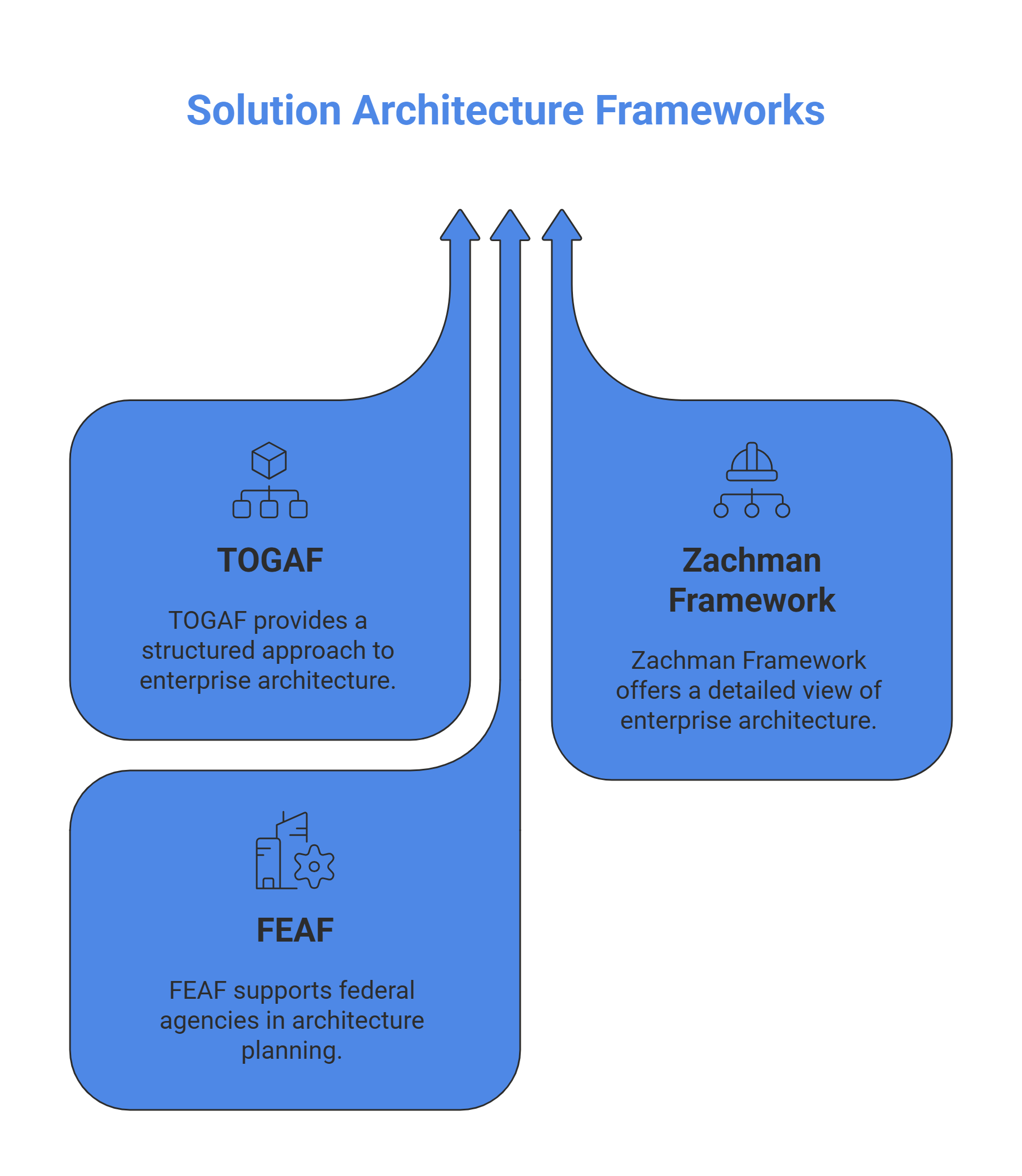
- TOGAF
- Zachman
- FEAF
1. TOGAF (The Open Group Architecture Framework)
TOGAF is one of the most popular and comprehensive enterprise architecture frameworks in use today. Developed by The Open Group, it provides a detailed methodology called the Architecture Development Method (ADM) for designing, planning, implementing, and governing enterprise architecture.
Key Features:
- ADM Process: A step-by-step approach for creating architectures across phases (e.g., Business, Application, Data, and Technology).
- Enterprise Continuum: Supports reuse of existing architectural assets.
- Standards-Based: Aligns with industry standards and encourages interoperability.
Why It’s Used:
TOGAF is ideal for large organizations aiming for consistency across multiple business units and technology systems. It helps in aligning IT with long-term business strategy.
2. Zachman Framework
The Zachman Framework is a pioneering approach to enterprise architecture that uses a structured, grid-based matrix to categorize different aspects of an organization’s architecture. It focuses on defining what, how, where, who, when, and why — across different stakeholder perspectives.
Key Features:
- 6x6 Matrix: Organizes architecture into six perspectives (Planner to Subcontractor) and six interrogatives (What, How, Where, Who, When, Why).
- Highly Descriptive: More focused on classification than process.
- Non-Prescriptive: Unlike TOGAF, it doesn’t tell you how to build—just what to consider.
Why It’s Used:
Zachman is ideal for organizations looking for a holistic and detailed view of their enterprise, especially in documentation-heavy environments or as a complement to other methodologies.
3. FEAF (Federal Enterprise Architecture Framework)
FEAF is a U.S. government-developed framework designed to align federal IT investments with business goals. It provides a common approach for agencies to plan and manage IT resources effectively.
Key Features:
- Reference Models: Includes models for performance, business, service, data, and technical architecture.
- Governance Focus: Strong emphasis on compliance, reporting, and investment management.
- Standardized Language: Supports collaboration across different government departments.
Why It’s Used:
FEAF is particularly useful for public sector organizations that require clear governance structures, reporting standards, and investment transparency.
Enterprise Architecture vs Solution Architecture vs Technical Architecture
| Criteria | Enterprise Architecture (EA) | Solution Architecture (SA) | Technical Architecture (TA) |
| Focus | The entire organization’s IT and business alignment | Specific solution to a business problem | Detailed implementation of specific technologies |
| Scope | Organization-wide (strategic) | Project or solution-specific (tactical) | Component-level or system-level (operational) |
| Objective | Align business and IT across the enterprise | Bridge the business needs and technology for a specific project | Ensure proper implementation of technology components |
| Time Horizon | Long-term strategic planning | Medium-term solution delivery | Short-term technical execution |
| Stakeholders | Executives, CIOs, enterprise planners | Project managers, product owners, business analysts, and development leads | Developers, IT operations, and infrastructure teams |
| Key Deliverables | Enterprise roadmap, capability maps, reference architectures | Solution blueprint, architecture diagrams, integration plans | Technical specifications, infrastructure designs, configs |
| Governance Roles | Sets policies, standards, and principles | Ensures solution fits within EA guidelines | Enforces technical standards and best practices |
| Example | Defining cloud adoption strategy across departments | Designing an integrated CRM + billing system | Setting up microservices, configuring cloud infrastructure |
Read More: |
Conclusion
In this article, we learned that solution architecture is essential for translating business needs into effective technology solutions. We explored the role of the Solution Architect, key stages of the architecture process, core components, real-world examples, and popular frameworks like TOGAF, Zachman, and FEAF. We also compared solution architecture with enterprise and technical architecture, showing how each plays a unique role. Overall, solution architecture ensures that IT initiatives are aligned, efficient, scalable, and valuable to the business.
Whether you're building enterprise applications, migrating to the cloud, or scaling your infrastructure, having a seasoned Solution Architect on your team can make all the difference. So if you want to go ahead, then choose wisely choose Scholarhat's Azure Solution Architect Certification and be a master in it.

